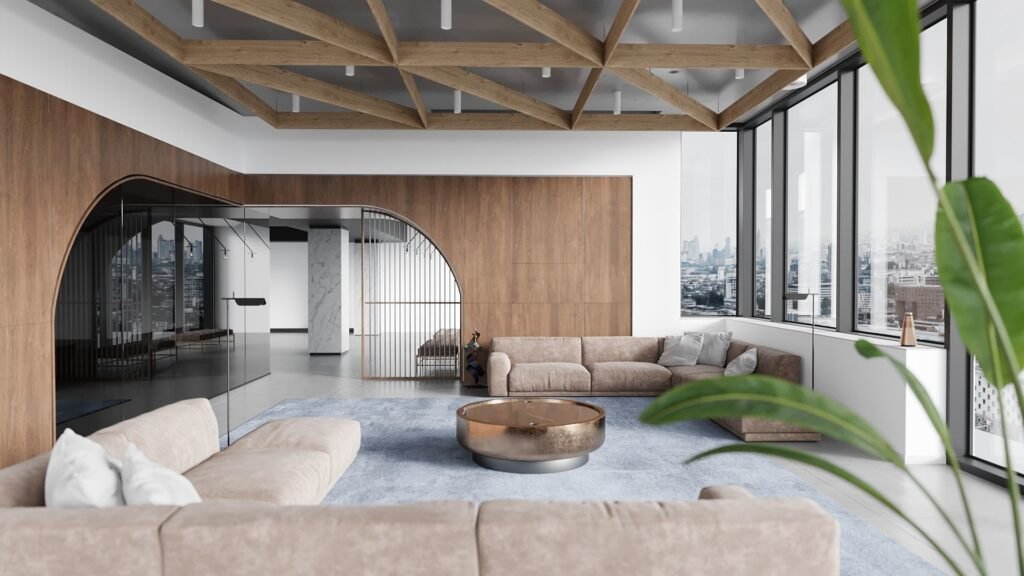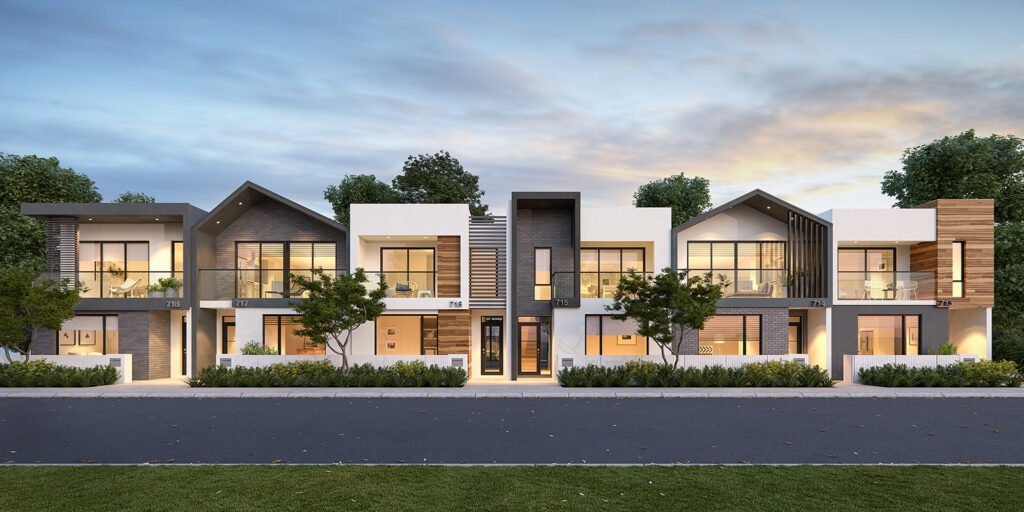In a competitive real estate landscape, details matter and how you present those details can make all the difference. Visual storytelling through CGI (computer-generated imagery) provides a dynamic way to convey the essence of a property, weaving design, functionality, and emotion into a powerful narrative.
At ArchiRender3D, we believe that every property has a story to tell, and our stunning visual renderings help bring these stories to life.
In this guide, we’ll explore the vital role of CGI in property narratives, its benefits, techniques for crafting compelling stories, and real-world examples that prove its effectiveness.
Introduction: The Magic of Visual Storytelling in Real Estate
Imagine stepping into a space that hasn’t yet been built, where each detail from the play of natural light across a luxurious lobby to the inviting textures of a cozy living area is rendered in vivid clarity.
Visual storytelling through CGI turns that dream into an experience, enabling investors, buyers, and stakeholders to connect emotionally with a property before even stepping on site.
In the world of property marketing, it isn’t enough to provide dry technical details. A well-crafted CGI narrative transforms architectural plans into sensory experiences, conveying not just what a property looks like, but how it feels.
Whether you’re showcasing a modern urban development or a serene suburban retreat, CGI provides an invaluable tool to communicate your vision with passion and precision.
What is CGI in Property Narratives?

CGI, or computer-generated imagery, is the art of creating lifelike, immersive visuals from digital models. In property narratives, Property CGI bridges the gap between imagination and reality by transforming floor plans, sketches, and concepts into dynamic visual experiences.
These visuals can be still images, animated fly-throughs, or interactive virtual tours that capture every detail of a space.
Key Characteristics of CGI in Property Narratives:
- Realistic Detailing: From the texture of stone to the reflections on glass, CGI replicates real-world surfaces and materials, delivering an authentic feel.
- Immersion: Through carefully crafted camera movements and lighting setups, viewers are invited to experience a property as if they were physically there.
- Story Integration: CGI enables designers to weave narratives into visual presentations, highlighting how a property’s design adapts to various moods and moments.
By harnessing the potential of CGI, architects and marketers can turn mundane blueprints into captivating stories that resonate with their audience.
The Benefits of CGI in Property Storytelling
Integrating CGI into property presentations comes with a range of powerful benefits, making it a crucial element in today’s real estate marketing strategies.
1. Enhanced Emotional Connection
Visual storytelling transcends mere presentation, it evokes emotion. High-quality CGI allows prospective buyers or investors to “feel” a space before it exists.
- Immersive Experiences: Detailed visuals invite viewers into a narrative, enabling them to connect emotionally with the property.
- Memorable Impressions: When people can visualize themselves living or working in a space, the emotional impact can lead to stronger engagement and enhanced decision-making.
2. Improved Communication and Clarity
CGI breaks down complex architectural plans into intuitive, visually digestible narratives.
- Clear Representation: CGI highlights the spatial relationships, design details, and material finishes that might be lost in technical drawings.
- Effective Collaboration: When every stakeholder—from architects to financiers—can see and interact with the visual narrative, misunderstandings are minimized and collaborative decisions are easily reached.
- Instant Understanding: A well-crafted visual narrative communicates the concept in a way that appeals to both the head and the heart, speeding up approval processes.
3. Accelerated CGI Marketing and Sales
In a market where first impressions count, CGI provides a competitive edge that accelerates engagements and closes deals faster.
- Compelling Digital Content: Whether it’s for websites, social media, or digital brochures, CGI visuals capture attention and drive higher engagement.
- Shortened Sales Cycles: Immersive virtual tours and detailed renderings allow clients to experience a property remotely, leading to quicker purchasing decisions.
- Investor Assurance: Detailed, photorealistic visuals build trust and present a believable, attractive prospect that can ease investment concerns.
4. Cost and Time Savings
Investing in CGI early on brings significant long-term savings by mitigating risks and minimizing rework during construction.
- Error Detection: Detailed CGI narratives can reveal design flaws or spatial issues before construction begins, reducing costly changes later on.
- Efficiency Gains: With clear visuals, project teams experience fewer delays due to miscommunication, thereby optimizing timelines and budgets.
- Outsourcing Advantage: Outsourcing CGI services to experts like ArchiRender3D transforms fixed costs into scalable, project-based expenses, ensuring you receive top-quality visuals without the overhead of an in-house team.
5. Future-Proofing Your Brand
By embracing CGI, you position your brand as forward-thinking and innovative, ready to meet the ever-evolving demands of modern property marketing.
- Scalability: CGI solutions are adaptable, catering to projects of various sizes—from intimate residential projects to expansive commercial ventures.
- Consistent Branding: High-quality visuals that align with your brand’s values help maintain a consistent, professional image across all marketing channels.
- Long-Term Value: As customers increasingly seek immersive experiences, investing in CGI ensures that your marketing assets remain relevant and impactful for years to come.
Crafting a Compelling CGI Narrative: Techniques and Best Practices

Creating an effective CGI narrative is both an art and a science. Below are some techniques that ensure your property visual story is told with clarity, punch, and emotion.
Define Your Narrative Arc
Begin with a clear vision by outlining the story you want your visuals to tell. Consider what makes the property unique and how you want your audience to feel as they engage with the narrative. Ask essential questions:
- What is the overall message of the property?
- What emotions should the viewer experience—excitement, serenity, luxury?
Establishing a narrative arc provides a guiding framework for your CGI project. This arc should have a beginning that introduces context, a middle that highlights the unique features and functions, and an end that leaves a lasting impression of the space’s potential.
By mapping out the flow and key moments, you ensure that every scene builds on the previous one, creating a cohesive and engaging story.
Start with a Well-Developed Storyboard
A detailed storyboard is the blueprint of your CGI narrative. It outlines the sequence of scenes, camera angles, and transitions necessary to convey your narrative effectively. Spend time refining your storyboard to include:
- Key Scenes: Identify pivotal moments that highlight the property’s best features.
- Transition Points: Plan how you will move from one scene to the next, ensuring smooth and natural shifts in focus.
- Visual Cues: Note the lighting, textures, and perspectives that will enhance each scene’s emotion and clarity.
This planning phase reduces the risk of inconsistencies and helps maintain focus throughout production, ensuring every render contributes to a unified narrative.
Harness the Power of Lighting and Atmosphere
Lighting is one of the most effective storytelling tools in CGI. It sets the mood, defines space, and draws the viewer’s attention to details that matter. Techniques include:
- Natural Lighting: Simulate different times of day to showcase how the property feels from dawn to dusk. Soft early morning light can evoke calm and serenity, while afternoon brightness might highlight the vibrancy of a space.
- Mood Lighting: Use accents and shadows strategically. Warm tones can create a sense of comfort, and cooler hues might lend a sophisticated, modern feel.
- Contrast and Depth: Balancing bright and dark areas in your scene not only adds visual interest but also assists in emphasizing focal points within the narrative.
Thoughtful lighting transforms flat images into immersive experiences, drawing viewers deeper into the story you’re telling.
Master Dynamic Camera Movements
The way you guide the viewer’s eye is crucial for maintaining engagement. Dynamic camera movements can create a cinematic experience that feels natural and fluid. Consider these techniques:
- Smooth Transitions: Use gentle pans, zooms, and dolly movements to allow the viewer to explore the space effortlessly.
- Varying Perspectives: Alternate between wide-angle shots that reveal the full environment and close-up shots that capture intricate details.
- Identifying Focal Points: Guide the viewer to the property’s key features, ensuring the storyline emphasizes what makes the space unique and inviting.
By carefully planning your camera paths, you generate a rhythm within the narrative that enhances clarity and drives the story forward.
Emphasize Fine Details and Textural Realism
The magic of CGI often lies in its attention to the small things. Fine details—the grain of a wooden table, the shimmer of light on a polished surface, or even the interplay of fabrics in a cozy living room—can make the difference between a generic presentation and one that feels authentic.
- Texture Mapping: Ensure that every material reflects its natural properties. High-resolution textures can replicate the tactile quality of real surfaces.
- Subtle Imperfections: Incorporate minor details and natural imperfections, which add realism and warmth to the visual narrative.
These details not only build authenticity but also enhance the emotional connection between the viewer and the space.
Pacing and Transition: Maintaining a Narrative Rhythm
A well-paced narrative maintains audience interest without overwhelming them. Consider the following best practices:
- Balanced Pacing: Alternate between slow, contemplative shots and more dynamic sequences to create a natural ebb and flow.
- Clear Transitions: Each scene should smoothly lead into the next, ensuring a continuous flow that keeps viewers engaged throughout the journey.
- Narrative Peaks: Build moments of climax—such as the reveal of a spectacular view or a grand entrance—before returning to detailed explorations of individual spaces.
A thoughtful pacing strategy ensures that your visual narrative captures attention while conveying the full story of the property.
Iterate and Refine Through Feedback
The creative process is never complete in one pass. Regularly seek feedback from team members and early viewers to refine your narrative. This iteration may involve:
- Review Sessions: Host internal and client meetings to review storyboards, rough renders, and final outputs.
- Adjusting for Clarity: Be willing to make changes that improve the flow, transitions, and emphasis of key details.
- Final Tweaks: Fine-tune colors, lighting, camera angles, and other elements to ensure that the final product is seamless and compelling.
This collaborative approach not only enhances the quality of the final narrative but also ensures it resonates well with the intended audience.
Integrating CGI into Your Marketing Channels
CGI doesn’t just bring properties to life, it elevates your entire CGI marketing strategy. Here’s how visual storytelling through CGI works across different channels:

Online Portfolios and Websites
High-quality CGI images and visuals enhance your online presence, ensuring your website stands out in search results and captivates potential clients from the first click.
- Interactive Elements: Embed animated fly-throughs or virtual tours that invite users to explore properties in real time.
- SEO-Friendly Content: Use engaging visuals alongside keywords that boost your visibility in property and design searches.
Social Media Campaigns
Social media is a powerful platform for sharing stunning visuals. CGI renders make your posts shareable and memorable.
- Engaging Visuals: Eye-catching animations and dynamic images increase engagement and drive social shares.
- Storytelling Formats: Utilize short video clips or interactive posts that tell a story, fostering a deeper connection with your audience.
Digital Brochures and Presentations
Whether you’re pitching a project to investors or presenting a portfolio to clients, CGI-based materials elevate the professionalism of your presentations.
- Compelling Narratives: Integrate CGI visuals into slide decks, flyers, or digital brochures to provide a persuasive visual narrative that supports your pitch.
- Consistent Branding: Maintain visual consistency across all materials to strengthen your brand identity and build trust with your audience.
Investor and Client Meetings
When it comes to high-stakes meetings, a powerful CGI presentation can make all the difference.
- Immersive Experiences: Provide stakeholders with an interactive, visual experience of the property that reinforces your vision and inspires confidence.
- Clear Communication: High-fidelity visuals help reduce ambiguity and ensure that every detail of the design is understood, making decision-making easier and more efficient.
Challenges and Considerations
While CGI offers remarkable benefits, creating truly effective visual narratives requires careful consideration:
Balancing Creativity and Accuracy
- Authenticity vs. Artistry: Ensure that your visuals maintain fidelity to the actual design while still engaging the viewer with creative storytelling.
- Expectations Management: Set realistic expectations with clients regarding the level of detail and time required to produce high-quality CGI renderings.
Maintaining Consistent Quality
- Quality Control: Robust quality checks are essential throughout the process—from modelling and texturing to lighting and post-production.
- Collaboration: Regular feedback loops with clients help ensure that the final product aligns with the envisioned narrative and design intent.
Managing Project Timelines
- Realistic Deadlines: High-quality CGI renderings take time; project managers must account for iterative revisions and refinements.
- Resource Allocation: Ensure that sufficient time and budget are allocated, balancing creativity with efficient project management.
Looking Ahead: The Future of CGI in Property Narratives
As property narratives continue to evolve, so too does the role of CGI in transforming how we experience and market properties. Here are some trends to watch:
Interactive Experiences
- Enhanced Engagement: Future CGI developments will offer even more interactive experiences, allowing stakeholders to navigate virtual spaces freely.
- Client Customization: Personalized visual narratives that adapt to the viewer’s needs and preferences can further boost engagement and conversion rates.
Deeper Visual Story Integration
- Multi-Scene Narratives: Future visual storytelling may incorporate multi-scene animations that capture different moods and aspects of a property, creating a richer narrative.
- Emotional Storytelling: A greater focus on narrative arcs will deliver not only accurate representations but also stories that resonate deeply on an emotional level.
Broader Accessibility
- Cloud-Based Collaboration: Improved cloud solutions will make it easier for teams to work remotely and collaborate in real time, ensuring that every detail is perfected.
- Cross-Platform Experiences: Advances in display technology will enable seamless integration across various devices, making it easier for audiences to experience CGI narratives anywhere, anytime.

CGI Visual Storytelling
Visual storytelling through architectural CGI is not merely an artistic endeavor—it’s a strategic tool that transforms property narratives and elevates every aspect of real estate marketing. By turning static designs into immersive, photorealistic experiences, CGI helps you communicate your vision with clarity, inspire emotional connections, and drive faster, more informed decision-making.
Whether you’re targeting investors, engaging clients, or building your brand, a well-crafted CGI narrative can set your projects apart in a competitive market.
At ArchiRender3D, we are dedicated to bringing your property stories to life with precision, creativity, and heart through our 3D architectural rendering services. Let us help you transform your architectural ideas into captivating visual journeys that not only impress but also achieve tangible results.
Embrace the power of visual storytelling and watch your property narratives flourish.
FREQUENTLY ASKED QUESTIONS
What is CGI in the context of property narratives?
CGI (computer-generated imagery) is a technique for creating photorealistic, digital visualizations of architectural designs that bring property narratives to life with immersive detail.
How does CGI enhance architectural storytelling?
CGI enables the creation of dynamic, engaging visuals that reveal every design detail, evoke emotions, and help potential buyers, investors, and stakeholders connect more deeply with a property.
What are the primary benefits of using CGI for property marketing?
The benefits include enhanced communication, faster decision-making, cost savings through error prevention, improved sales cycles, and a stronger brand presence in the market.
How does visual storytelling impact client engagement?
By creating immersive, memorable experiences, visual storytelling helps clients imagine themselves in the space, which can lead to quicker commitments and stronger investor confidence.
What techniques are used to create compelling CGI narratives?
Techniques include realistic lighting and texturing, dynamic camera movements, detailed modelling, structured storyboarding, and effective post-production to ensure a cohesive and emotional visual journey.
How are CGI visuals integrated into marketing strategies?
They are used in website portfolios, social media campaigns, digital brochures, presentations, and interactive virtual tours that collectively create a consistent and engaging brand experience.
How does ArchiRender3D ensure the success of CGI property narratives?
ArchiRender3D combines expert craftsmanship, a collaborative process, meticulous quality control, and a commitment to storytelling excellence to deliver CGI visuals that captivate and inspire.





